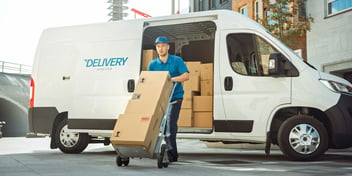
How to Run a Successful Trucking Business
Trucking is one of the most profitable businesses in the US, with professional fleet owners earning around $500-$2000 weekly per truck.
But earning such amounts doesn’t come easy. The trucking business is quite competitive, so if you’re a small business owner looking to run a successful trucking company, you must increase the number of trucks you own to expand your routes. Luckily, there are financing options such as trucking business loans to help you kickstart your expansion plans and scale up your business in the trucking industry.
There’s a lot to keep track of as a trucking owner:
- You have to manage your finances
- Make sure you have the proper permits
- Maintain safety and quality standards for your trucks
- Keep up with industry trends
In this blog post, we’ll walk you through some tips for running a successful trucking business. So read on for advice on everything from establishing a business plan and marketing strategy to choosing suitable vehicles!
7 Steps to Run a Successful Trucking Company
Starting your own trucking company was one of the highlights of your life, but running it is another story. Trucking businesses that have been in the industry for a few years must have already gotten the basics covered, like getting a commercial driver’s license, registering their company, opening a business bank account, and recruiting truck drivers.
To keep your business profitable and in line with current trends in supply and demand, you need to have a solid business plan to execute your expansion goals. Do you want to target new markets? If so, which markets are you interested in, and which one is feasible? Do you want to serve new areas? If so, which are those areas located within your state or outside?
Whichever goal you choose, having a clear plan and strategy will help you make better decisions and save you the cost of risking your trucking operation by jumping on an idea too soon. If you’ve created a business plan, the next part focuses on how you run your trucking company professionally. So check out these seven steps that will help you get there!
1. Choose a Niche and Establish Good Relationships
As a trucking company owner, it’s essential to establish a clear vision and mission for your company. This will help you stay on track and know what direction to take when expanding or scaling down.
Many fleet owners start by finding a profitable niche to grow their businesses around. For example, if you own a fleet of refrigerated trucks, you could begin to provide regular deliveries to grocery stores in the area.
Once you choose your niche, it’s time to build solid relationships with your partners. Remember, you’re not going to serve them for a few months; you’re looking for a long-term partnership. So ensure to pick up and deliver on time and with as few errors as possible to gain their trust.
2. Choose the Right Truck for Your Business Goals
There are endless variables to consider when choosing a vehicle for your fleet. To ensure your choice is profitable in the long term, you should take into account the cost of vehicle maintenance and fuel. You might also want to choose a vehicle that’s already popular in your market - having a fleet full of trucks with similar specifications can make it easier to find replacement parts.
It’s also important to keep track of the mileage on each truck, as this will help you plan your company’s expansion and replacement schedule. If your credit is good enough, you can always opt for a third-party leasing option or hire an individual owner-operator to run your trucks. This will allow you to stay lean and only pay for the services you need.
3. Manage the Maintenance of Your Vehicles
Taking good care of your fleet is essential to running a successful trucking business. Just like your trucks, you need to keep track of the wear and tear that comes with each job.
Trucking companies can find managing employees working outside of their regular hours daunting. This is where vehicle monitoring software can help you reduce costs and improve efficiency. You don’t even have to buy a tracking device yourself - some services offer a fully-managed GPS fleet tracking solution.
4. Get the Right Permits for Your Business
Different states have different requirements when it comes to commercial trucking. If you don’t have the correct permits, you could face steep fines for operating illegally - and it could even jeopardize your insurance.
If you plan to drive across provincial or state lines, you may need a special permit from government authorities. Some jurisdictions have checkpoints where drivers are asked for relevant documentation, so it’s a good idea to keep all your paperwork up-to-date.
Make sure you have the right insurance before heading out on the road as well. And guarantee that your employees are also aware of their responsibilities when driving across states.
5. Manage and Hire Qualified Drivers
The most important thing is to hire reliable and qualified drivers. As a business owner, you can’t be on the road 24/7, so you need to select who will be heading out in harsh conditions carefully.
It’s essential to have a clear company policy regarding speeding, driving under the influence, and keeping logs of hours behind the wheel. It can be tempting to cut costs by hiring cheaper labor, but you may end up regretting that decision if your drivers are constantly getting into accidents or getting on the wrong side of the law.
You also can’t expect to hire a new driver and immediately send them on long-distance trips for weeks at a time. It would be best if you relied on your fleet, so you will have to invest in some form of initial training before drivers are allowed to jump behind the wheel.
For long-distance trips, using dedicated fleet management software makes it easy to keep track of your drivers, their activities and routes, and any accidents they might be involved in.
6. Cut Down Costs Through Direct Shipping
Direct shipping may be worth considering if you have a long-standing client base. This means that your drivers will carry deliveries directly to customers. This reduces your organization’s reliance on third-party carriers and load boards and can help you avoid additional costs from using a broker.
You could also save money by being more efficient in the way you handle shipments - for example, if an order is received late, don’t send it out right away or pay for expedited shipping. You may be able to negotiate a better rate with your client the next time you make a delivery.
As long as you run your brokerage operation in an organized, efficient way, it’s possible to save money on your fleet without losing customers or profits. By cutting out unnecessary costs and reducing inefficiencies, you may be able to keep rates lower while still offering a high-quality service.
7. Market Your Trucking Company
Many small business owners ask how to market their trucking company. It can seem difficult to attract attention when you’re running a small company that is just getting off the ground. Here are some tips you can start marketing your business that won’t cost you a lot:
Truck Load Boards
Trucking load boards are designed for both trucking companies and customers in need of trucking services. By using a load board, drivers will be able to pick up countless loads from shippers and brokers.
The following sites will allow users to search two ways. First, as a transportation business owner, you can search for loads that need to be transported. There’s also an option for customers to visit the site and search for trucks in the area that can pick up a load. The following sites offer this service:
- Direct Freight Services
- Trucker Path
- 123 Load Board
- Trulos
- Freight Finder
- Landstar Carriers
- Truckers Edge
Ads in Trade Publications
Trucking companies with a presence in the industry can’t afford to be left behind. Print ads are just as important, and trade publications offer an excellent way for truckers looking at expanding their business or learning more about what they do have available resources on hand.
When it comes time to place your ad, you might consider publishing in trade publications that cover the services or products of your chosen target industry. This database is organized by industry so find what’s right for yours!
While many subscribers prefer the print version, others will read the publication online. To reach both audiences, you need to invest in digital advertising to target businesses in your geographic area.
Trade Association Events
Trade associations offer you the opportunity to get in touch with an engaged audience. For example, if you seek new drivers, you could set up a booth at a trucking industry trade show.
If you’re choosing to market your services to other businesses, you should attend B2B-focused events. Take a look at this list of upcoming trade shows to find those that include trucking services that your company offers. Remember to create a visually appealing and informative display to attract customers and print marketing materials to send home with attendees.
Become a Successful Trucking Business Owner
Once you start a trucking company, you need to ensure that all challenges are handled as efficiently as possible. Creating a business plan, hiring the right truck drivers, keeping track of regulations and permits, and handling your marketing strategy should help you reach new heights sooner than you think.
No doubt, these steps cannot be done without additional financing, so if you’re ready to make your trucking business more successful, our lending experts at Select Funding will provide you with suitable financial solutions!




